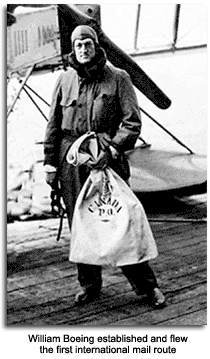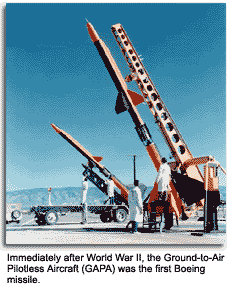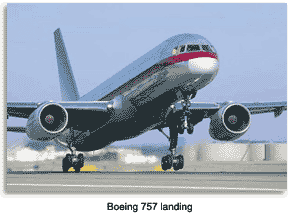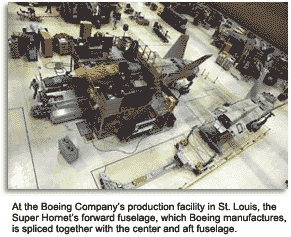As one of many success stories of the early 1900s in America, the Boeing Company grew from a hobbyist’s vision to an industry leader in aircraft manufacturing.
The early years
Born in Detroit in 1881, William Edward Boeing graduated from Yale University in 1904. The young man then went west to enter the lumbering business.
At that point, he observed what was happening in Kitty Hawk and became interested in flight as a means of transportation.
Boeing began to fly in 1911 under the tutelage of Glenn L. Martin, who would later found an airplane manufacturing company of his own.
Martin developed the B-10 bomber series, including the 123, 139, and 166 models, which set the standard in the 1920s. The company also developed a streamlined monocoque fuselage, variable-pitch propellers, metal wings with lift-enhancing flaps, and retractable landing gear.
From hobby to business partnership
Boeing teamed up with U.S. Navy Lieutenant George C. Westervelt in 1914 to build the Bluebell seaplane, better known as the B&W. When Westervelt was transferred to Washington, D.C., Boeing completed the plane and took it on its maiden flight in June 1916.
One month later, Boeing set in motion the beginnings of an industry behemoth by creating the Pacific Aero Products Company. One year later, he renamed the venture Boeing Airplane Company.
One of Boeing’s key early hires was Tsu Wong, one of the country’s few aeronautical engineers. As the U.S. entered World War I, Wong developed the Model C training seaplane for the Navy. Boeing built 56 Model Cs with 55 going to the Navy and one to Bill Boeing, who called his personal aircraft the C-700. Boeing also hired Claire Egtvedt and Phil Johnson, who would become Boeing company presidents.
Post-World War I
After 1918, orders for more aircraft ceased. As the fledgling company struggled to survive, they built such furniture as dressers and counters, as well as “sea sleds,” or flat-bottomed, sea-going boats, from leftover wood stocks.
In early 1919, Boeing and Eddie Hubbard, the pilot, carried 60 letters in the C-700 from Vancouver, B.C., to Seattle, Washington, thereby delivering the first international airmail.
 Fighters, air mail, and passenger planes
Fighters, air mail, and passenger planes
In a race with Curtiss Aeroplane and Motor Company in 1923 to produce the best pursuit fighter, Boeing settled for second place. Six months later, however, Boeing debuted the Model 15. The aircraft so pleased the U.S. Army that they ordered nearly 600 of them. Boeing's entry into the air-mail industry was the Model 40 in 1923. By 1927, Boeing's Model 40A, now powered by a lighter air-cooled engine, won a contract to carry mail between Chicago, Illinois, and San Francisco, California. Owing to government regulations, a new company had to be set up to run the new airline, calling it Boeing Air Transport (BAT).
During its first year of service, BAT carried more than 800,000 pounds of mail, about 150,000 pounds of express packages, and nearly 2,000 passengers.
That stimulated the idea of a 12-passenger, three-engine Model 80, Boeing’s first biplane built specifically for passengers, which debuted in 1929. It was later upgraded to the Model 80A, an 18-passenger aircraft.
Before Charles A. Lindberg crossed the Atlantic in 1927, there had been little interest in passenger service by the airlines — only 5,800 passengers had flown in 1926. Four years later, however, the total had soared to more than 400,000 passengers.
Postmaster General Walter F. Brown wanted to encourage the trend. He disliked the Kelly Act, which provided subsidies of $3 per pound. Some gold-digging airlines were making good money by sending cast-iron stoves as airmail. Brown wanted the airlines to put more energy into developing the passenger side of air service. McNary-Watres Act
The McNary-Watres Act, also known as the Air Mail Act (1930), gave Brown the power to award air-mail contracts to stronger, more-organized airlines. Boeing’s place in the air mail industry
In order for airlines to capitalize on government air mail contracts, they needed larger, faster aircraft.
Air mail became a big revenue source for the fledgling plane builders, including the Donald Douglas company and Martin Aircraft. The railroads considered this to be a threat to their own revenue stream and lobbied for privatization of airmail without government interference (no subsidies).
The Kelly Act of 1925 helped to create the air transport industry by turning the new airlines into privately owned businesses, but regulated by the federal government.
By 1929, under the umbrella firm of United Aircraft and Transportation Company, Boeing enlarged its interests to include the Stearman Aircraft Company in Wichita, which manufactured engines and propellers. It also delivered mail, maintained airports, ran airlines, and trained pilots and mechanics at the Boeing School of Aeronautics.
Enter the monoplane
Biplanes were destined for museum status when, in 1930, Boeing introduced its line of monoplanes — the mail- and cargo-carrying "Monomail" and the company's first single-winged fighter, the XP-9, the predecessor to the P-26 "Peashooter," which flew 27 mph faster than any of Boeing's bi-winged models.
The Monomail design was destined to become the precursor to the Model 247 airliner, and became a mainstay of United Airlines in 1933.
The 247's design was so successful that its sleek exterior was adapted to produce Boeing's first monoplane bomber, the B-9, which was shaped like a cigar and given the moniker, "Flying Panatela."
The big shakeup
Antitrust legislation following the Depression denied airframe manufacturers the ability to control air mail operators. Boeing was forced to reorganize into several smaller entities, including an air-transportation unit (UAL), an east-coast manufacturing operation (United Aircraft, and later United Technologies), and the west-coast operation of Boeing Airplane Company, of which Stearman and Boeing Aircraft of Canada were already a part.
Those events disheartened William Boeing, who resigned his chairmanship and retired to raise horses. He would later return to help during World War II.
The Egtvedt Era
Claire Egtvedt, the longtime Boeing employee and new company president in 1933, took the company reins and envisioned a future of large passenger airplanes and new-age bombers. In 1934, the U.S. Army Corps was in the market for a heavy, long-range bomber. Boeing’s answer was the B-17 “Flying Fortress" with four engines and a wingspan of 149 feet.
Those developments carried over to the civilian world as well. The Model 314 “Clipper” series, the luxurious flying boat destined to make the first scheduled passenger trans-Atlantic flight; and the Stratoliner, the first pressurized airliner, were introduced.
As the threat of war drew near, Boeing’s production plants went underground, in a manner of speaking. To hide from potential air attack, the plant in Seattle camouflaged its rooftops by building burlap houses with chicken-wire lawns. When viewed from the air, the rooftops appeared to be just another suburb.
The war years produced a unique phenomenon — “Rosie the Riveter.” As men went off to war, thousands of women filled the labor gap. Production jumped from 60 planes per month in 1942 to an extraordinary 360 planes per month by March 1944, and in one Herculean effort, pushed out 16 planes in 24 hours.
During that time, Boeing produced the B-29 “Superfortress” in 1942 at facilities in Renton, Washington, and Wichita, Kansas. The latter plant became famous for its employment of housewives, shopkeepers, and farmhands in what became known as the “Battle of Kansas.”
The war effort from 1936 and 1944 also produced an unusual spirit of cooperation among aircraft manufacturers. B-29s were built by Boeing, Martin, and Bell Aircraft, while B-17s were built by Boeing, Lockheed, and Douglas.
Postwar years
Amid the obligatory layoffs following the end of World War II, Boeing plunged ahead with development of jet-engine technology, boosted by knowledge gained from captured data from German wind tunnels.
Boeing’s version of the wind tunnel was the largest privately owned facility and was instrumental in the development of the first six-engine, swept-wing jet bomber, the B-47. That model was quickly followed by the first eight-engine, long-range, swept-wing bomber, the now-fabled B-52, which first took flight in April 1952.
That advancement in technology allowed Boeing to commit $16 million to a prototype for large-scale passenger jet transport. The result was the Model 367-80, affectionately known as the “Dash 80.”
The Dash 80 technology was built into the first jet aerial tanker, the KC-135 Stratotanker, and a commercial airliner, the Model 707-120, or more familiarly, Boeing 707. That fuel-efficient carrier could carry as many trans-Atlantic passengers in a year as the Queen Mary ocean liner, for one-sixth the investment ($5 million) and one-tenth the cost for fuel.
 Missiles enter the picture
Missiles enter the picture
As the Cold War ground on, the Ground-to-Air Pilotless Aircraft (GAPA) produced during World War II in response to German “buzz bombs,” set the stage for such defensive weapons as the 45-foot Bomarc missiles, built in 1957.
That experience prompted the military to award Boeing the contract for the Minuteman intercontinental ballistic missile project, that included design and installation of missile bases and the maintenance support system.
A growing family The 707, now with turbofan engines designed to reduce noise and increase efficiency, became the standard bearer for an entire family of jet planes built for specific purposes. The 727 was Boeing’s entry into the smaller airport/runway market. It was the only tri-jet built by the company.
The enormous 747 jumbo jet was built to carry more passengers and help to relieve crowded airports.
One model of the 707, the 120B, was used to transport government officials and was dubbed “Air Force One” when the United States president was on board. Other models of the 707 were used until 1990 when they were replaced by versions of the 747 mainframe.
The Airborne Warning and Control System (AWACS) used the 707 mainframe as its platform beginning in 1976, and continued until 1991 when the 767 took over.
The space race
When U.S. president John F. Kennedy announced to the world in 1961 that America would put a man on the moon by the end of the decade, Boeing president William M. Allen loaned 2,000 executives to the National Aeronautics and Space Administration (NASA) to organize the venture, including the entire Apollo Program. Boeing was involved in the construction of the lunar orbiters, which photographed the moon’s surface and sent the images back to earth for NASA to choose the most advantageous landing sites for the astronauts. The lunar roving vehicles used by the astronauts also were built by Boeing.
Boeing's involvement did not end there. They were responsible for perhaps the most critical element of the entire project — the S-1C first-stage booster for the Saturn V rocket that would propel U.S. astronauts into history. The booster, America’s largest ever, was 138 feet high and provided enough thrust to cast a 120-ton payload into orbit around the earth. It was also used to put Skylab into orbit in 1973.
The Seventies
As euphoric as the Sixties were for Boeing, the early Seventies were, at best, sobering, and at worst, downright scary.
As the Apollo program was scaled back, Boeing looked to new revenue sources. The expected success of the 747 was slow in coming — Boeing went 18 months without a domestic order. Congress had pulled the plug on Supersonic Transport (SST) subsidies in March 1971. By October, Boeing’s Seattle-area workforce was cut by more than half to slightly more than 35,000.
The ex-employees created a mass exodus, prompting a billboard that read, “Will the last person leaving Seattle turn out the lights?”
Scrambling to stay aloft, Boeing was forced to diversify, and diversify they did. Boeing created a major presence in the commercial computer products industry, courted nearly 150 government and civilian clients, and launched a number of computer training centers across the country.
Other ventures involved them in a desalinization plant in the Virgin Islands, construction of light-rail cars for systems in San Francisco and Boston, installing irrigation systems in the high-desert country of eastern Oregon, constructing huge wind turbines in the Columbia River gorge, and managing housing projects for governmental agencies, to name a few.
Not everything was dormant in the aeronautical department, however. In 1973, a Boeing-built Mariner 10 space probe was launched with a course set for Venus and Mercury. Short-range attack missiles were still being built, and work started on more than 1,700 cruise missiles.
The Eighties
As the recession eased its grip, the Renton, Washington, plant rolled out the 1,000th 737.
 Environmental restrictions, combined with rising fuel prices, forced companies to produce more energy-efficient aircraft. Boeing responded with upgraded versions of the 737, 757, and 767. They also produced the Model 234, a civilian conversion of a Chinook military helicopter.
Environmental restrictions, combined with rising fuel prices, forced companies to produce more energy-efficient aircraft. Boeing responded with upgraded versions of the 737, 757, and 767. They also produced the Model 234, a civilian conversion of a Chinook military helicopter.
Relatively small-scale military projects included work on the F/A 22 fighter, the Comanche armed reconnaissance helicopter, the Osprey tiltrotor, the Avenger air defense system, and the Roland surface-to-air missile system.
The Nineties
Under the leadership of president Frank Shrontz in the mid-80s, Boeing landed work on the B-2 stealth bomber and upgrades on the B-52 and KC-135. Other projects moving the company into the Nineties were the Joint Strike Fighter and the remote-controlled DarkStar.
In the space group of Boeing, the Initial Upper Stage booster was built to help place satellites into high Earth orbit. The Sea Launch was built to launch civilian satellites. In addition, Boeing became the prime contractor on the first International Space Station.
In December 1996, Boeing Company and the defense and aerospace units of Rockwell International Company merged. The subsidiaries were renamed Boeing North American. Another merger, this one with McDonnell Douglas Corporation in August 1997, continued to streamline operations and consolidate market positions.
 The Future
The Future
As the new millennium dawned in March 2001, the company announced plans to move its world headquarters offices from Seattle to Chicago, and began operations there in September.
The aerospace giant was now poised to expand its influence throughout the industry, including work on the next generation of Global Positioning System satellites, integrating global communications, high-speed Internet, and entertainment and data services.
Boeing now has customers in 145 countries, employees in more than 60 countries, and operations in 26 states. From the Big Four of Boeing, Douglas, McDonnell, and North American, there has emerged one enormous enterprise, “building the future of flight on Earth and beyond.”